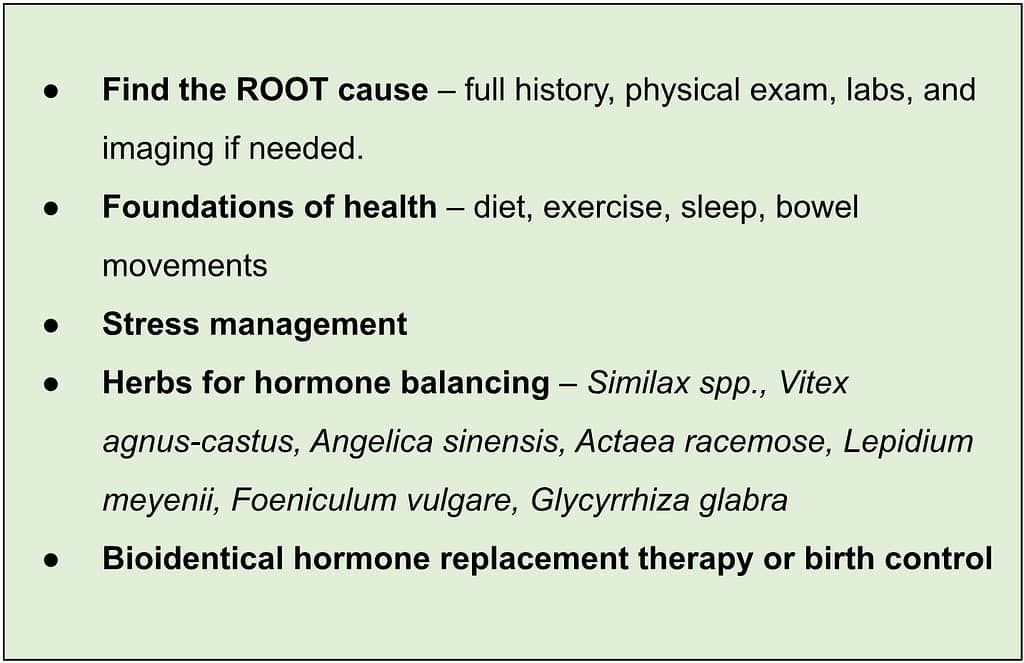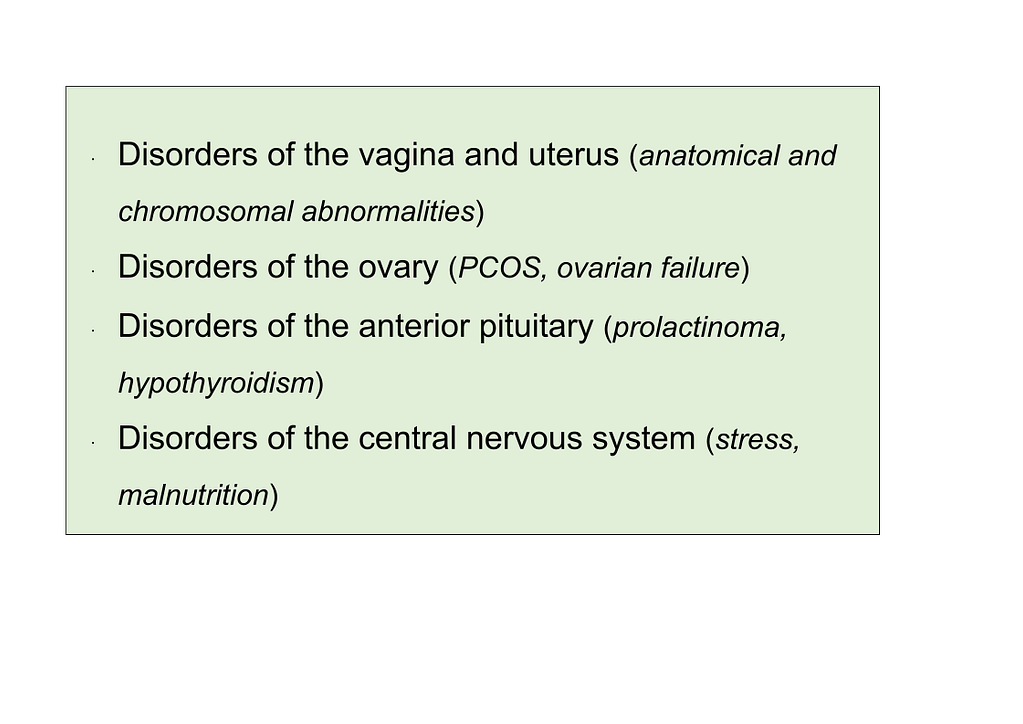| Written by: Dr. Alice Veirs |
In the third part of this series, I am going to discuss the most common causes of irregular periods and naturopathic considerations and natural treatments.
In part one of this series, I discussed how to count the days of your menstrual cycle. One of the reasons this is important is because you can easily tell if you are having irregular cycles or periods. Many women may notice this after a few cycles but if you are tracking your cycle, it makes it much more obvious when something is off.
There are 3 types of irregular periods
- Amenorrhea – the absence of a period for 3 months in a woman with regular cycles and 6 months in a woman with irregular cycles. It is considered abnormal if you are 15 or older and not yet had a period.
- Oligomenorrhea – periods that are spaced far apart. You may go 35 days or longer between periods.
- Polymenorrhea – periods that occur too close together. You may go 21 days or less between periods.
Causes of Amenorrhea
- Primary amenorrhea
- Pregnancy
- Hypothalamic amenorrhea
- Prolactinoma
- Cushing syndrome
- Primary ovarian insufficiency
- PCOS
- Menopause
- Uncontrolled chronic disease
Amenorrhea has two subcategories – primary and secondary. Primary amenorrhea means that no period has occurred by the age of 15, or 3 years after breast development. Primary amenorrhea is most often due to a chromosomal abnormality. Anatomical abnormalities are the second most common cause, where the uterus or vagina is partially or completely absent.
Secondary amenorrhea means that a previously menstruating woman has stopped (see above description). The most common cause of secondary amenorrhea is pregnancy and after that is menopause. Due to these two vastly different subcategories of amenorrhea, it is further organized into four classifications.
These are the 4 main causes and disorders associated with Amenorrhea
By classifying amenorrhea this way, it allows for easier diagnosis. Your primary care provider can narrow down the affected system and refer to a specialist if needed. A specialist is always needed in the case of primary amenorrhea. Every diagnosis starts with a detailed history, including past medical history and family history. A naturopathic doctor will also dive into your diet and lifestyle. Excessive stress and lack of certain nutrients, especially fat, can lead to low hormones which can cause periods to become abnormal or stop altogether.
Even though it may be nice to go without a period, it is important to address amenorrhea as it comes with health risks. The main risks of amenorrhea include:
- Reduced fertility
- Osteoporosis – this can lead to bone fractures
- Cardiovascular disease
- Endometrial hyperplasia – thickened uterine lining
Estrogen is very important for bone and heart health in women. This is why a post-menopausal woman is at higher risk for osteoporosis and cardiovascular disease. It is important to maintain bone and hearth health as long as possible before your sex hormones naturally drop later in life. The lack of fluctuation in progesterone and estrogen during amenorrhea means the uterine lining is not being shed and may build up and become problematic. A thickened uterine lining can lead to heavy bleeding, clots, and even cancer.
Causes of Oligomenorrhea
- Polycystic ovarian syndrome (PCOS)
- Prolactinoma
- Hyperthyroidism
- Hypothalamic oligomenorrhea
- Pelvic inflammatory disease
- Congenital adrenal hyperplasia
- Primary ovarian insufficiency
- Cushing syndrome
- Perimenopause
- Physiologically normal in adolescence
- Uncontrolled diabetes
- Drugs
- Cancer
Oligomenorrhea is often not considered worrisome to women experiencing it until they want to get pregnant. But this can be a first sign that something is amiss, as female (and male) sex hormones are very sensitive to changes. Alterations in diet, stress levels, and other hormones in the body can all impact the rise and fall of sex hormones. Low fat in the diet, high levels of stress, infections, and problems with your thyroid can all cause periods to become infrequent.
Polycystic ovarian syndrome is perhaps the most well-known cause of infrequent periods. A future blog post focusing on PCOS will be posted, so I will not go into much detail in this one. Besides oligomenorrhea 4 main symptoms of PCOS include:
- Hirsutism – abnormal hair growth on the chin, upper lip, thighs, and chest
- Weight gain
- Acne
- Hair loss
PCOS comes with features of insulin resistance and high androgens along with infrequent periods. It is the most common cause of infertility and is often treated with hormonal birth control. If a woman with PCOS wants to get pregnant and comes off their birth control, they may still have fertility problems due to the PCOS remaining untreated. Naturopathic doctors have many non-hormonal treatments for PCOS that may allow a woman to get pregnant without strong medical intervention.
Causes of Polymenorrhea
- Menarche
- Perimenopause
- Short luteal phase
- Short follicular phase
- Anovulation
- Endometriosis
- Uterine Fibroids
- Uterine or cervical polyps
- Sexually transmitted infection
- Cervicitis
- Pelvic inflammatory disease
- Bleeding disorder
- Stress
- Cancer
Polymenorrhea is less common than amenorrhea or oligomenorrhea and usually occurs in women 40-50 years old with perimenopause. As a woman’s sex hormones start to change in perimenopause menstrual irregularities occur and periods can become closer together. They can also spread out and will eventually stop in menopause. Young women can also experience polymenorrhea during menarche (the first period) as their bodies are trying to regulate their sex hormones.
Infections can cause more frequent bleeding and many experience bleeding after sex. Disorders stimulated by estrogen (fibroids, polyps, and endometriosis) can lead to frequent and heavy bleeding. Lastly, infections can cause frequent bleeding, either spotting (especially after sex) or more frequent menses. The risk of polymenorrhea is iron deficiency anemia, which is easily treatable. However, if the cause of the bleeding is not stopped or slowed, anemia can be persistent and lead to further complications.
Treatments
Treatment is always tailored to the individual. I never give the exact same treatment plan twice because I never have the exact same patient sitting in front of me. I also follow the therapeutic order. I start with the foundation of someone’s health first. If there are deficiencies, we work to correct those first. Then I add in more advanced therapies such as herbs or specific nutrients at therapeutic doses. Sometimes it is necessary to rely on stronger therapies such as bioidentical hormones or birth control. I always aim to meet the patient where they are at.

5 Main Treatments for Irregular Periods
Labs Used for Irregular Cycles
Basic blood tests that can be run by your primary care doctor or naturopathic doctor to assess hormone levels and other biomarkers that can influence those hormones:
- Complete blood count
- Comprehensive metabolic panel
- Thyroid hormones – TSH, free T3, freeT4
- Pituitary hormones – FSH, LH, Prolactin
- Sex hormones – Fractionated estrogens, progesterone, testosterone
- DHEA
- AM Cortisol
Other labs and Imaging for Irregular Cycles if indicated:
- Pap smear
- Vaginal culture
- Pelvic ultrasound
- Pregnancy test
Specialty testing such as a karyotype test for chromosomal abnormalities or laparoscopy for endometriosis should be done by a specialist (Gynecologist, Endocrinologist, OBGYN surgeon).
You don’t have to suffer from PMS. Talk to one of our naturopathic doctors today!
If you would like to discuss any of this information, you can schedule a free meet and greet with our naturopathic doctors by calling 480-256-2999 or texting 480-256-2829.


